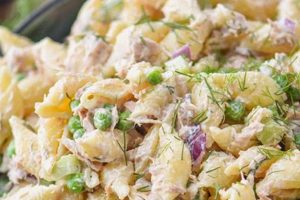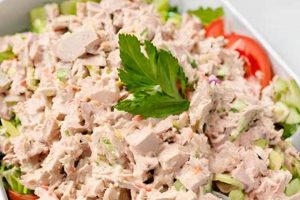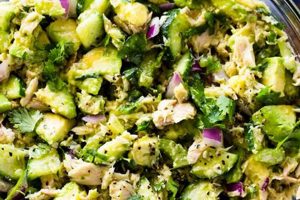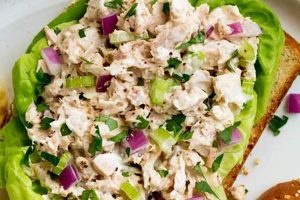A chilled pasta salad featuring cooked macaroni, canned tuna, and typically other ingredients such as mayonnaise, celery, onion, and seasonings constitutes a popular and versatile dish. Variations can include hard-boiled eggs, relish, peppers, or different herbs and spices. A simple combination of mayonnaise and tuna with macaroni forms the foundation, allowing for extensive customization based on personal preferences or available ingredients.
This type of dish offers several advantages. Its ease of preparation and relatively inexpensive ingredients make it an accessible and convenient meal option. It can be prepared in advance and served cold, making it ideal for potlucks, picnics, and quick lunches. The dish’s adaptability allows for creative variations catering to diverse tastes, from adding a spicy kick with jalapeos to incorporating Mediterranean flavors with olives and feta cheese. The historical evolution of this dish is intertwined with the rising popularity of canned tuna and convenience foods in the 20th century, becoming a staple in many cultures.
The following sections will delve into specific ingredient selections, preparation techniques, variations, and tips for achieving the perfect balance of flavors and textures. Nutritional information and storage guidelines will also be addressed to provide a comprehensive understanding of this culinary staple.
Tips for an Exceptional Macaroni Salad with Tuna
Achieving a flavorful and well-balanced macaroni salad with tuna involves attention to several key elements. The following tips offer guidance for optimizing ingredient selection, preparation methods, and overall presentation.
Tip 1: Pasta Perfection: Select small to medium-sized pasta shapes, such as elbow macaroni, shells, or rotini. Cook the pasta al dente to maintain a firm texture, as overcooked pasta can result in a mushy salad. Rinse the cooked pasta under cold water to stop the cooking process and cool it down quickly.
Tip 2: Tuna Selection: Opt for high-quality canned tuna packed in water or oil, depending on preference. Drain the tuna thoroughly before adding it to the salad to prevent excess liquid.
Tip 3: Mayonnaise Mastery: Use good quality mayonnaise as the base of the dressing. The amount can be adjusted to achieve the desired creaminess. Consider adding a touch of plain Greek yogurt for a tangier flavor and lighter texture.
Tip 4: Enhancing Flavors: Incorporating finely chopped celery, red onion, and fresh herbs such as dill or parsley adds depth and complexity. Experiment with other vegetables like bell peppers or chopped pickles for variations.
Tip 5: Seasoning Strategies: Season the salad with salt, black pepper, and other spices to enhance the flavors. A pinch of paprika or a dash of hot sauce can add a subtle kick.
Tip 6: Chilling Time: Allow the salad to chill in the refrigerator for at least 30 minutes before serving. Chilling allows the flavors to meld and enhances the overall taste and texture.
Tip 7: Presentation Matters: Serve the salad in an attractive bowl and garnish with fresh herbs, a sprinkle of paprika, or a few slices of hard-boiled egg for an appealing presentation.
By following these tips, one can create a macaroni salad with tuna that is both delicious and visually appealing. Careful attention to detail in each step, from pasta selection to chilling time, contributes significantly to the final product.
The following section provides a concluding overview and suggestions for further exploration of this versatile dish.
1. High-quality Tuna
Tuna quality significantly impacts the overall flavor and enjoyment of macaroni salad. Selection of the appropriate type and grade of tuna elevates the dish from simple to exceptional. This section explores the facets of high-quality tuna and their connection to a superior macaroni salad experience.
- Species and Grade:
Different tuna species offer varying flavor profiles and textures. Albacore, known for its light color and delicate flavor, is often considered premium. Yellowfin and skipjack are other common options with slightly stronger flavors. Grades within each species, such as “solid white” or “chunk light,” reflect differences in texture and fat content. Solid white albacore offers a firm, clean flavor, while chunk light tuna provides a more robust, savory experience. Choosing the right species and grade aligns the tuna’s characteristics with the desired overall flavor profile of the salad.
- Packing Medium:
Tuna is commonly packed in water or oil. Water-packed tuna offers a leaner option, allowing the natural flavor of the fish to shine through. Oil-packed tuna provides a richer, more decadent flavor, often with added herbs or spices. The choice between water and oil-packed tuna depends on personal preference and the other ingredients in the salad. Oil-packed tuna can complement a salad with bolder flavors, while water-packed offers a cleaner, lighter taste.
- Sourcing and Sustainability:
Sustainable fishing practices ensure the long-term health of tuna populations and the marine ecosystem. Choosing tuna from reputable sources committed to sustainable harvesting methods contributes to responsible consumption. Certifications such as those from the Marine Stewardship Council (MSC) provide guidance for selecting sustainably sourced tuna. These choices reflect a commitment to environmental responsibility while ensuring a high-quality product.
- Freshness and Storage:
Proper storage maintains tuna quality. Canned tuna should be stored in a cool, dry place until the expiration date. Once opened, any unused portion should be refrigerated in an airtight container and consumed within a few days. Fresh tuna, if used, should be handled and stored according to food safety guidelines to preserve its quality and prevent spoilage. Attention to freshness ensures the optimal flavor and texture of the tuna in the final dish.
Selecting high-quality tuna elevates the flavor profile of macaroni salad, transforming it from a simple side dish to a culinary highlight. Careful consideration of species, packing medium, sourcing practices, and freshness contributes to a more satisfying and flavorful experience.
2. Al dente pasta
Pasta texture plays a crucial role in the overall success of macaroni salad. “Al dente,” which translates to “to the tooth” in Italian, describes pasta cooked to a firm yet tender consistency. This specific texture is essential for achieving a pleasant mouthfeel and preventing a mushy, unappetizing salad. Understanding the characteristics and importance of al dente pasta provides a foundation for creating a superior macaroni salad.
- Texture and Mouthfeel:
Al dente pasta offers a slight resistance when bitten, providing a satisfying chewiness. Overcooked pasta, in contrast, becomes soft and mushy, resulting in a less appealing texture within the salad. The firm texture of al dente pasta holds its shape well, preventing the salad from becoming overly dense or compact. This textural contrast enhances the overall sensory experience.
- Absorption of Flavors:
Properly cooked al dente pasta absorbs the flavors of the dressing and other ingredients more effectively than overcooked pasta. The slightly porous surface of al dente pasta allows the flavors to permeate, resulting in a more flavorful and well-integrated salad. Overcooked pasta, with its compromised structure, tends to dilute the flavors of the dressing and other components.
- Visual Appeal:
Al dente pasta maintains its distinct shape, contributing to a visually appealing salad. The individual pieces of pasta remain separate and well-defined, preventing the salad from appearing clumpy or homogenous. This visual appeal enhances the overall presentation and enjoyment of the dish. Overcooked pasta, prone to sticking together, detracts from the visual presentation.
- Prevention of Sogginess:
Al dente pasta, with its firm structure, is less likely to become soggy when combined with the dressing and other ingredients. The controlled absorption of liquids prevents the pasta from becoming overly saturated, maintaining a pleasant texture even after chilling. Overcooked pasta, more susceptible to absorbing excess moisture, can contribute to a soggy salad, particularly after refrigeration.
Achieving the perfect al dente texture is paramount for creating a successful macaroni salad. This ideal consistency enhances the salad’s texture, flavor absorption, visual appeal, and resistance to sogginess. By prioritizing the proper cooking of the pasta, one ensures a more enjoyable and satisfying culinary experience.
3. Flavorful Mayonnaise
Mayonnaise serves as the foundational binding element in macaroni salad, significantly influencing the overall flavor profile. The quality and flavor complexity of the mayonnaise directly impact the final taste and enjoyment of the dish. This section explores the crucial role of flavorful mayonnaise in creating a truly satisfying macaroni salad with tuna.
- Base Mayonnaise Selection
The choice of base mayonnaise sets the stage for the overall flavor. Standard mayonnaise provides a neutral backdrop, while options such as olive oil mayonnaise or avocado oil mayonnaise impart subtle flavor nuances. Selecting a high-quality mayonnaise, preferably one made with natural ingredients, contributes to a richer, more authentic taste. The base mayonnaise acts as a canvas upon which other flavors are built.
- Customization and Flavor Enhancements
Flavorful mayonnaise extends beyond the base ingredient. Incorporating additional ingredients elevates the complexity and depth of the dressing. Common additions include Dijon mustard for tanginess, lemon juice for brightness, minced garlic for pungency, or sriracha for a touch of heat. Fresh herbs, such as dill or chives, add a refreshing herbal note. These additions transform the mayonnaise into a dynamic flavor component that complements the other ingredients in the salad.
- Balance and Proportion
Balancing the flavors within the mayonnaise is essential for creating a harmonious salad. The intensity of added ingredients should complement the tuna and other components without overpowering them. Careful consideration of proportions prevents any single flavor from dominating the overall taste. A well-balanced mayonnaise enhances the individual flavors of the other ingredients while contributing its own unique character.
- Texture and Consistency
Mayonnaise contributes to the overall texture of the salad. The right consistency ensures that the dressing coats the pasta and other ingredients evenly, creating a cohesive and enjoyable mouthfeel. Too thick a mayonnaise can result in a heavy, dense salad, while too thin a mayonnaise may not adequately bind the ingredients together. The ideal consistency allows the flavors to meld seamlessly while providing a pleasant textural experience.
Flavorful mayonnaise elevates macaroni salad with tuna from a simple dish to a culinary delight. The selection of the base mayonnaise, the incorporation of complementary flavors, the careful balance of proportions, and the attention to texture all contribute to the creation of a well-rounded and satisfying salad. Mayonnaise acts not merely as a binding agent but as a critical flavor component that elevates the overall dining experience.
4. Crisp Vegetables
Crisp vegetables provide essential textural and flavor contrasts within a macaroni salad with tuna. Their inclusion elevates the dish beyond simple carbohydrates and protein, introducing refreshing elements and contributing to a more satisfying sensory experience. This section explores the multifaceted role of crisp vegetables in enhancing macaroni salad.
- Textural Contrast and Variety
The crispness of vegetables offers a counterpoint to the softness of the pasta and tuna. This contrast in textures creates a more dynamic and engaging mouthfeel. Celery, for example, provides a satisfying crunch, while finely diced red onion introduces a sharp bite. This textural variety prevents the salad from becoming monotonous and adds to the overall enjoyment.
- Flavor Enhancement and Complexity
Crisp vegetables contribute a range of flavors that complement the tuna and mayonnaise. The peppery bite of radishes, the subtle sweetness of bell peppers, or the herbaceous notes of chopped parsley add depth and complexity to the overall flavor profile. These additions prevent the salad from tasting bland and create a more well-rounded culinary experience.
- Nutritional Value and Visual Appeal
The inclusion of crisp vegetables increases the nutritional value of macaroni salad. Vegetables provide essential vitamins, minerals, and fiber, contributing to a more balanced and healthful meal. Furthermore, their vibrant colors enhance the visual appeal of the salad, making it more attractive and appetizing. The visual contrast of colorful vegetables against the creamy mayonnaise and pasta adds to the overall presentation.
- Variety and Customization
The selection of crisp vegetables offers opportunities for customization and personalization. Traditional choices like celery and onion can be complemented or replaced with other options such as chopped carrots, cucumbers, or blanched green beans. This flexibility allows for tailoring the salad to individual preferences and exploring diverse flavor combinations. The adaptability of crisp vegetables ensures a versatile and adaptable dish.
The strategic incorporation of crisp vegetables elevates macaroni salad with tuna from a simple combination of ingredients to a more complex and satisfying dish. Their contribution of textural contrast, flavor enhancement, nutritional value, and visual appeal transforms the salad into a well-rounded culinary experience. Careful selection and preparation of these vegetables ensures a delightful balance of flavors and textures, enhancing the overall enjoyment of this classic dish.
5. Balanced Seasonings
Balanced seasonings are essential for a successful macaroni salad tuna recipe, transforming it from bland to flavorful. Seasoning influences the overall taste profile, enhancing the inherent flavors of the tuna, mayonnaise, and vegetables. A proper balance prevents any single flavor from dominating, allowing the individual components to harmonize. Salt, black pepper, and paprika are fundamental seasonings. Salt enhances other flavors while pepper adds a subtle bite. Paprika contributes a warm, smoky note. The quantity of each seasoning depends on the specific ingredients and personal preferences. Over-seasoning can overwhelm the palate, while under-seasoning results in a lackluster dish. For example, if using a particularly salty tuna, less added salt is required. Conversely, milder tuna may require more seasoning to achieve the desired flavor intensity. This dynamic interplay of seasonings directly impacts the overall culinary experience.
Beyond basic seasonings, herbs and spices offer opportunities to create unique and complex flavor profiles. Dill, parsley, and chives introduce fresh, herbaceous notes. Garlic powder or onion powder add savory depth. A touch of cayenne pepper provides a subtle kick. The judicious use of these seasonings elevates the dish, adding layers of flavor that complement the core ingredients. For instance, the brightness of dill pairs well with the richness of tuna, while a hint of garlic powder enhances the savory notes of the mayonnaise. These additions cater to individual preferences and allow for creative variations. Experimentation is key to discovering optimal flavor combinations. However, restraint is crucial. Overuse of herbs and spices can create an unbalanced and overpowering taste, masking the delicate flavors of the other ingredients.
Achieving balanced seasonings requires careful consideration of the interplay between ingredients and seasonings. Tasting and adjusting throughout the preparation process is crucial. Initial seasoning establishes a foundation, but further adjustments might be necessary after chilling, as flavors can meld and intensify over time. This iterative approach ensures the final product achieves a harmonious balance. Understanding the impact of seasonings and employing a thoughtful approach elevates the macaroni salad tuna recipe, creating a dish that is both flavorful and balanced. The result is a more satisfying and enjoyable culinary experience, showcasing the synergy between high-quality ingredients and carefully chosen seasonings.
6. Adequate Chilling Time
Adequate chilling time is a crucial element in preparing macaroni salad with tuna, significantly impacting flavor development and overall enjoyment. Chilling allows the diverse flavors of the ingredientspasta, tuna, vegetables, and mayonnaiseto meld and harmonize, creating a more cohesive and balanced flavor profile. This process also enhances the salad’s texture, firming the pasta and intensifying the flavors of the other components.
- Flavor Enhancement
Chilling allows the individual flavors of the ingredients to blend and mature. The initially distinct tastes of the tuna, mayonnaise, vegetables, and seasonings gradually merge, creating a more complex and unified flavor profile. This fusion of flavors results in a more nuanced and satisfying culinary experience, as the individual components complement and enhance one another.
- Texture Improvement
Chilling firms the pasta, preventing it from becoming mushy or overly soft. This improved texture provides a more pleasant mouthfeel and contributes to the overall structural integrity of the salad. The chilled temperature also enhances the crispness of the vegetables, further contributing to the textural complexity of the dish.
- Food Safety
Chilling inhibits bacterial growth, ensuring the safety of the macaroni salad, particularly important for dishes containing mayonnaise. Maintaining the salad at a safe temperature below 40F (4C) prevents the proliferation of harmful bacteria and extends the shelf life of the prepared dish. This practice aligns with food safety guidelines and safeguards against potential health risks.
- Optimal Serving Temperature
Macaroni salad is traditionally served cold, and chilling achieves the ideal serving temperature. The cool temperature enhances the refreshing qualities of the salad, making it particularly enjoyable in warmer weather. Serving the salad chilled also amplifies the perceived crispness of the vegetables and the creamy texture of the mayonnaise, contributing to a more satisfying sensory experience.
Adequate chilling time is integral to maximizing the quality and enjoyment of macaroni salad with tuna. By allowing sufficient time for flavor development, texture enhancement, and temperature regulation, one ensures a more satisfying and safer culinary experience. Chilling not only improves the overall taste and texture but also contributes to the safe consumption of this classic dish.
7. Creative Variations
Creative variations within a macaroni salad tuna recipe demonstrate the dish’s adaptability and potential for personalization. Moving beyond the standard formula unlocks opportunities to cater to individual preferences, explore new flavor combinations, and elevate the dish from familiar to innovative. This exploration of creative variations highlights the versatility of this culinary staple.
- Ingredient Swaps and Additions
Ingredient substitutions offer a straightforward path to customization. Different pasta shapes, such as rotini or farfalle, introduce textural variety. Chickpeas or cannellini beans can replace or complement tuna for a vegetarian adaptation or protein boost. Incorporating ingredients like chopped apples, grapes, or dried cranberries introduces sweetness and textural complexity. The addition of olives, capers, or feta cheese transforms the salad into a Mediterranean-inspired dish.
- Flavor Profile Adjustments
Flavor profiles can be dramatically altered through the incorporation of various herbs, spices, and sauces. A Southwestern flair can be achieved through the use of chipotle powder, cumin, and chopped cilantro. Curry powder and chopped mango create an Indian-inspired variation. A classic Italian twist emerges with the addition of pesto, sun-dried tomatoes, and artichoke hearts. These adjustments cater to diverse palates and offer endless possibilities for experimentation.
- Dressing Diversification
Moving beyond traditional mayonnaise-based dressings opens avenues for exploring new flavor dimensions. A vinaigrette dressing made with olive oil, lemon juice, and Dijon mustard adds a tangy, lighter alternative. A creamy avocado dressing introduces a healthy fat component and a smooth, rich texture. Experimenting with different dressing bases contributes significantly to the overall flavor profile and can transform the character of the salad.
- Presentation and Serving Styles
Presentation elevates the dining experience. Serving the salad in individual portions, such as in hollowed-out tomatoes or bell peppers, creates a visually appealing and elegant presentation. Layering the salad ingredients in a clear glass bowl showcases the vibrant colors and textures. Garnishing with fresh herbs, a sprinkle of paprika, or a drizzle of olive oil adds a finishing touch that enhances the visual appeal.
Creative variations transform the macaroni salad tuna recipe from a basic staple into a platform for culinary exploration. By incorporating diverse ingredients, adjusting flavor profiles, experimenting with dressings, and focusing on presentation, one can elevate this classic dish into a personalized and memorable culinary creation. These variations showcase the adaptability of the recipe and its potential to satisfy a wide range of tastes and preferences.
Frequently Asked Questions
This section addresses common inquiries regarding macaroni salad with tuna, providing concise and informative responses to clarify potential uncertainties and enhance understanding of the recipe’s nuances.
Question 1: What type of tuna is best suited for macaroni salad?
Canned tuna packed in water or oil is recommended. Albacore offers a delicate flavor, while yellowfin or skipjack provide a more robust taste. The choice depends on individual preference.
Question 2: How can sogginess be prevented in macaroni salad?
Cooking the pasta al dente, ensuring the tuna is well-drained, and using the appropriate amount of mayonnaise helps prevent sogginess. Thorough chilling also contributes to maintaining the desired texture.
Question 3: How long can macaroni salad with tuna be stored?
Properly stored in an airtight container in the refrigerator, macaroni salad with tuna typically lasts for three to five days. It is important to observe visual and olfactory cues for spoilage before consumption.
Question 4: Can macaroni salad with tuna be frozen?
Freezing is generally not recommended, as the mayonnaise-based dressing can separate and become watery upon thawing, negatively impacting the texture and overall quality of the salad.
Question 5: What are some healthy variations of macaroni salad with tuna?
Using whole wheat pasta, incorporating a variety of vegetables, reducing the amount of mayonnaise, and substituting Greek yogurt for a portion of the mayonnaise contribute to a healthier version.
Question 6: Can this recipe be adapted for vegetarian diets?
Replacing tuna with chickpeas, cannellini beans, or other legumes provides a protein-rich vegetarian alternative. Adjusting seasonings as needed ensures a balanced flavor profile.
Understanding these common points of inquiry facilitates successful preparation and enjoyment of macaroni salad with tuna. Careful consideration of these aspects ensures a positive culinary experience.
The following section provides a comprehensive recipe guide for creating a delicious and well-balanced macaroni salad with tuna.
Macaroni Salad Tuna Recipe
This exploration of the macaroni salad tuna recipe has highlighted the multifaceted nature of this seemingly simple dish. From the selection of high-quality tuna and the importance of al dente pasta to the nuances of flavorful mayonnaise and the incorporation of crisp vegetables, each component contributes significantly to the overall culinary experience. Balanced seasonings and adequate chilling time further enhance the final product, while creative variations offer a platform for personalized interpretations and culinary innovation. Understanding these elements allows for a deeper appreciation of the interplay of ingredients and techniques that transform basic components into a satisfying and enjoyable meal.
The macaroni salad tuna recipe stands as a testament to the potential for culinary excellence within seemingly ordinary dishes. Careful consideration of each ingredient and technique elevates this classic recipe beyond its humble origins, showcasing the power of thoughtful preparation and the enduring appeal of simple, well-executed cuisine. Further exploration and experimentation within this culinary framework promise continued enjoyment and discovery for both novice cooks and seasoned chefs alike.






